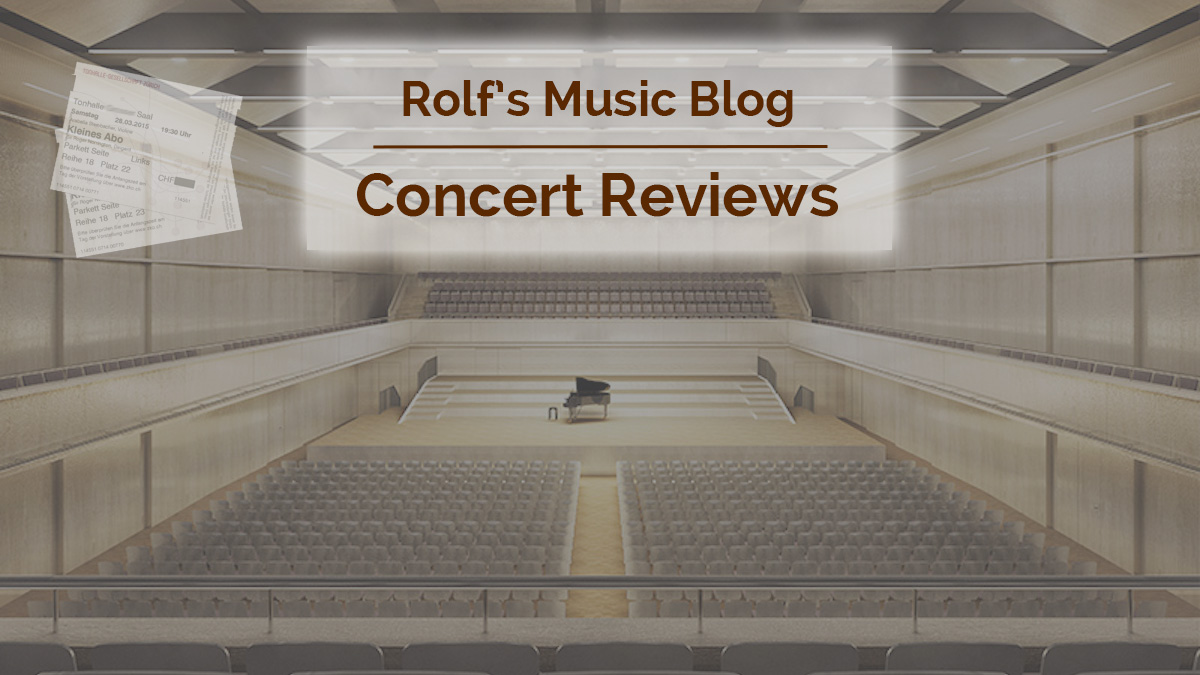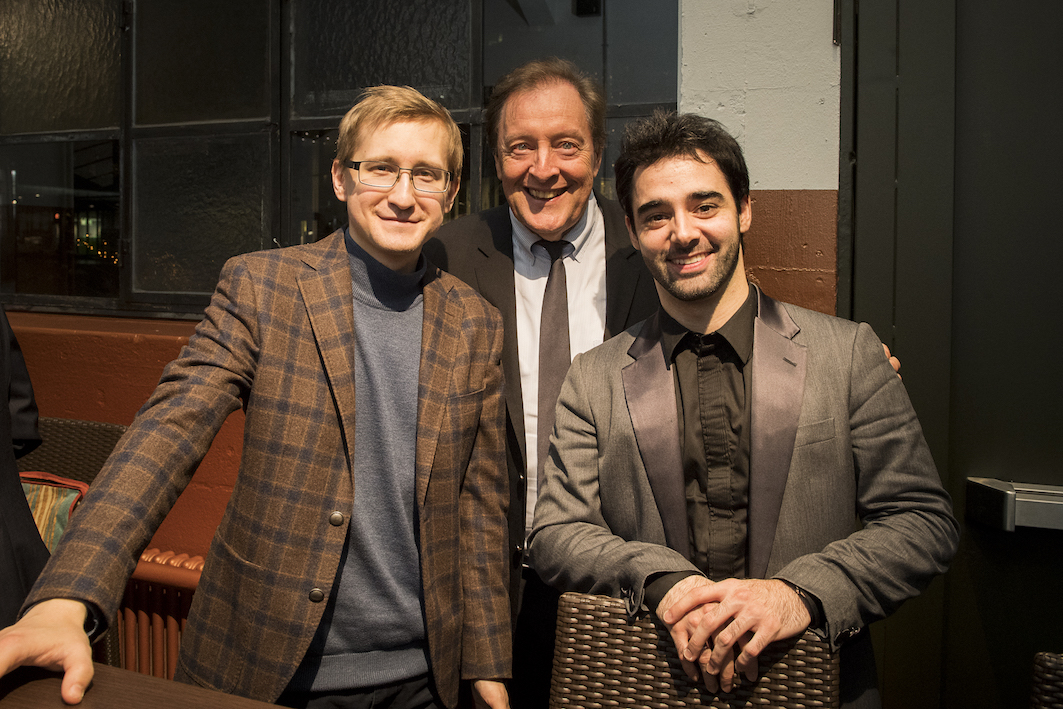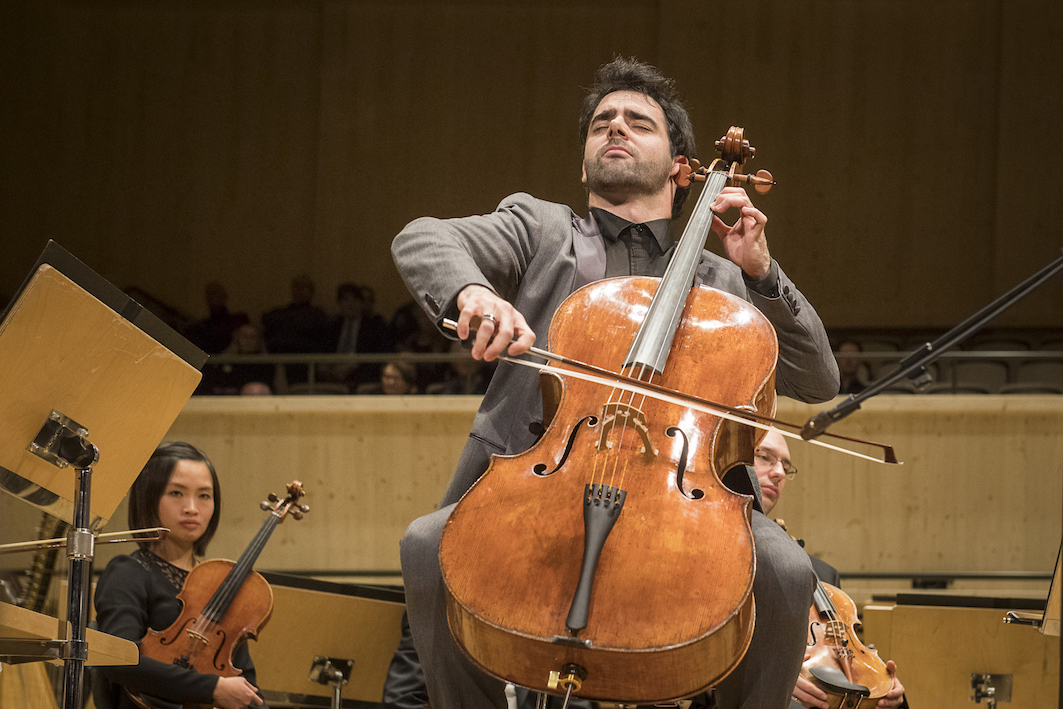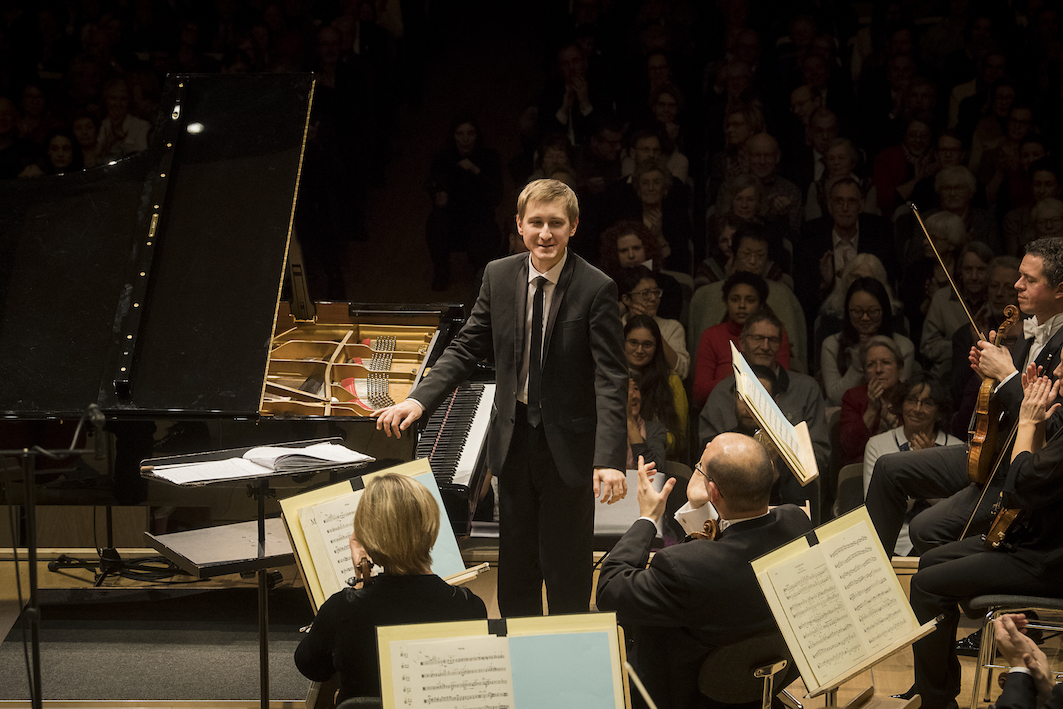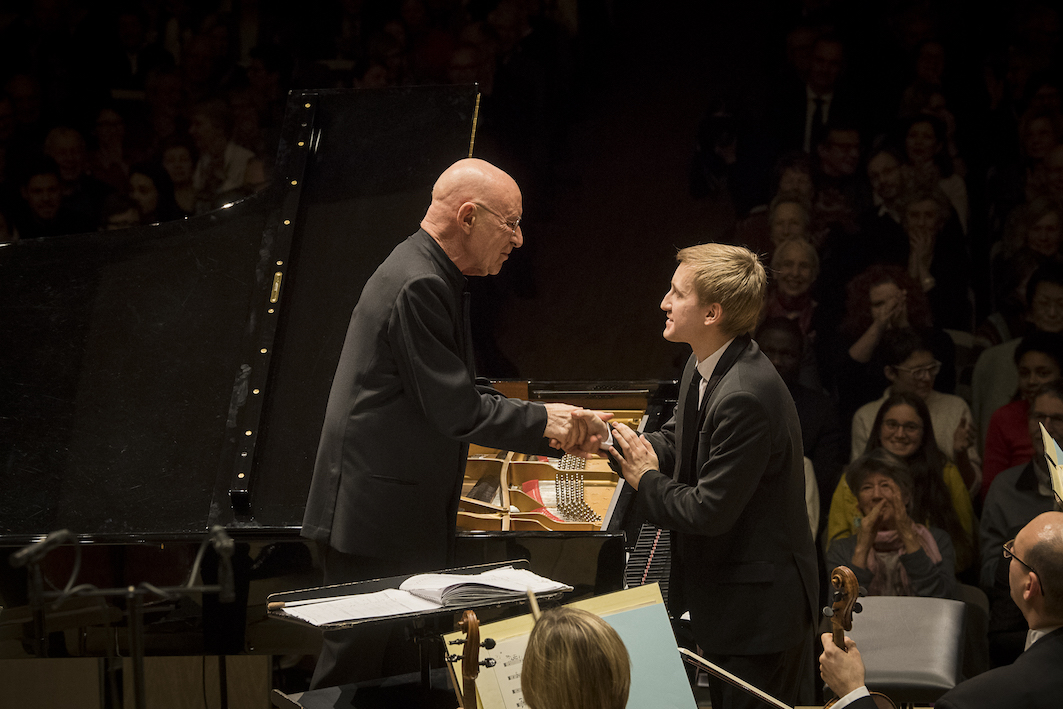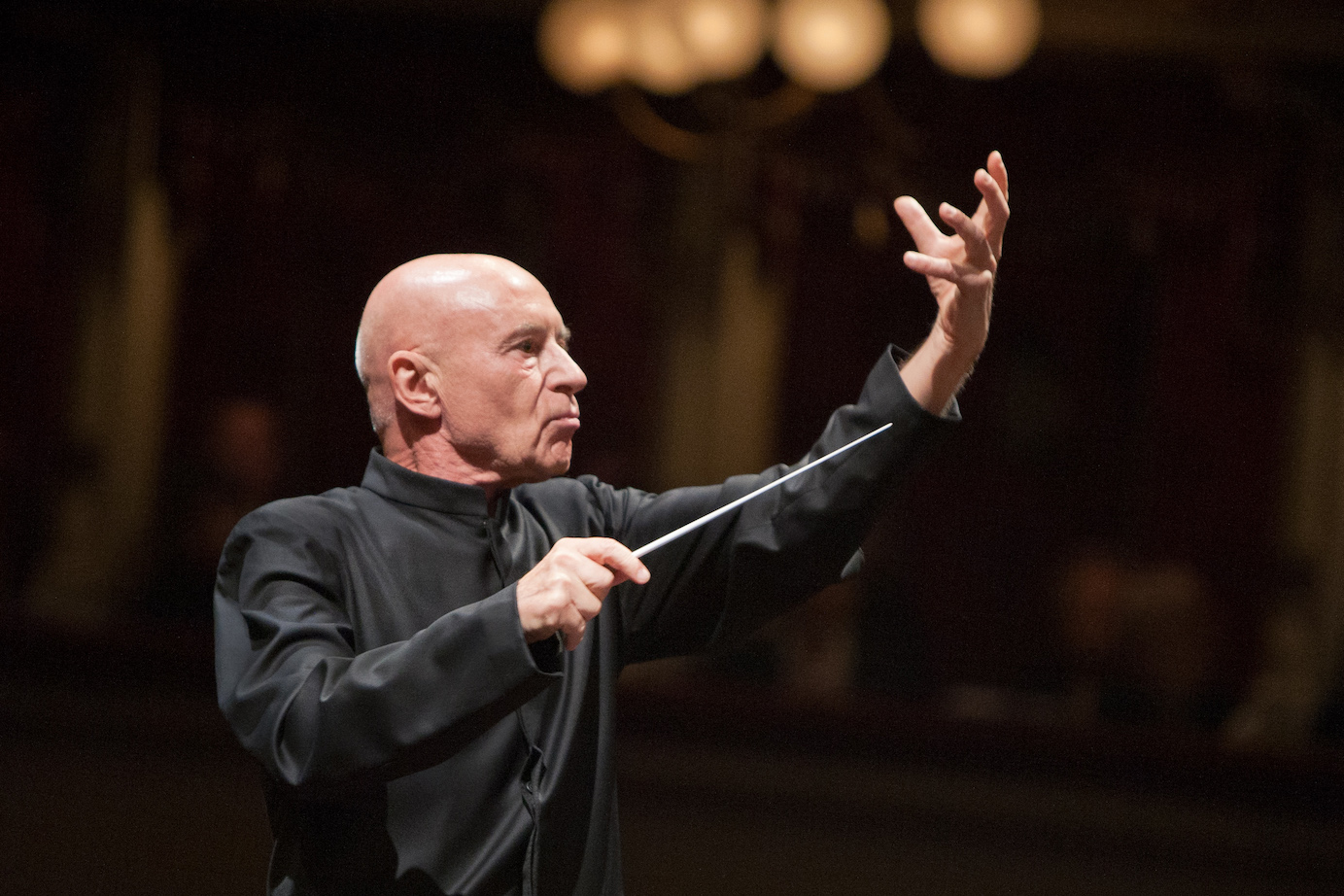Pablo Ferrández, Dmitry Masleev, Christoph Eschenbach / Bamberger Symphoniker
Haydn / Rachmaninoff / Mendelssohn
Tonhalle Maag, Zurich, 2017-12-18

2017-12-24 — Original posting
2018-01-11 — Added images provided by the Orpheum Foundation
Subtilität, Virtuosität und Gestaltungswille: Konzert der Orpheum Stiftung in Zürich — Zusammenfassung
Im Konzert der Orpheum Stiftung zur Förderung junger Solisten waren die Bamberger Symphoniker unter dem sorgfältig gestaltenden Christoph Eschenbach einfühlsame Begleiter zweier hervorragender Jungtalente, des Cellisten Pablo Ferrández und des Pianisten Dmitry Masleev.
Pablo Ferrández, hervorragend in seinen technischen Fähigkeiten, spielte das C-dur Konzert von Haydn mit eigenwilligen, fantasiereichen, gelegentlich gewagten Kadenzen. Im Schlusssatz war das Tempo etwas zu ambitiös, ließ den Zuhörer atemlos zurück.
Dmitry Masleevs unscheinbare Erscheinung, sein jugendliches, beinahe keckes Auftreten täuschten! Er ist 3 Jahre älter als Ferrández. Und als er zu spielen begann, offenbarten sich seine Virtuosität, seine Agilität, seine exzellenten technischen Fähigkeiten. In Rachmaninoffs spieltechnisch hoch anspruchsvollen Rhapsodie über ein Thema von Paganini unterliefen ihm kaum Fehler. Vielleicht, dass sein Spiel etwas sehr auf Virtuosität und Brillanz fokussiert?
Zum Abschluss dirigierte Christoph Eschenbach Felix Mendelssohns Reformationssinfonie. Dabei hinterließen die Bamberger den Eindruck eines hervorragenden Klangkörpers, von den Streichern und Holzbläsern bis hin zum Blech. Unter Eschenbachs Leitung erfuhr diese Sinfonie eine schlüssige, in ihrer natürlichen Musikalität überzeugende Interpretation.
Table of Contents
- Introduction
- Concert & Review
- Haydn: Cello Concerto Nr.1 in C major, Hob.VIIb:1
- Encore — Bach: Cello Suite No.3 in C major, BWV 1009 : 4. Sarabande
- Rachmaninoff: “Rhapsody on a Theme by Paganini” for Piano and Orchestra, op.43
- Encore — Rachmaninoff: Morceaux de fantaisie , op.3 : 1. Élégie in E♭ minor
- Mendelssohn: Symphony No.5 in D major/D minor, op.107, “Reformation”
Introduction
The Orpheum Foundation for the Advancement of Young Soloists was created in 1991. I have previously written about concerts that the foundation has organized for the young soloists that it supports. The first of the Foundation’s concert was given in the organization’s first year, 1991. The conductor back then was Christoph Eschenbach (*1940, see also Wikipedia). Also the orchestra back then was the same as in this concert, the Bamberger Symphoniker (see also Wikipedia).
While orchestra and conductor were the same as 26 years ago, this was the first Orpheum concert in the Tonhalle Maag, Zurich’s temporary, main concert venue (and hence also a first for conductor and orchestra).
Soloists
As in most of the Foundation’s concerts, this one presented two young soloists, a cellist and a pianist:
Dmitry Masleev, Piano
In the introduction to the piano concerto, Dmitry Masleev (born 1988 in Ulan-Ude in Siberia, East of Lake Baikal) was introduced with a nice anecdote by the radio presenter Eva Oertle. His parents were not musicians, but all he had was a little xylophone on which he played. On his first day at school, he did not find his designated class room. By mere coincidence, he ended up in the music class. There, the teacher asked him to play a popular folk tune on the piano. As he had played this on his xylophone, he managed the challenge. Apparently (se non è vero, è ben’ trovato) at the same time passed the admittance test for the music class. And as in that school the only instrument options were the accordion and the piano, his choice was clear…
Masleev received his main piano education from the Moscow Conservatory, where he studied with Mikhail Petukhov. Dmitry Masleev’s career breakthrough happened in 2015, when he won the first prize at the XV. International Tchaikovsky Competition in Moscow. Since then, he is touring the concert stages in Europe and America. For additional information see again Wikipedia.
Pablo Ferrández, Cello
Pablo Ferrández (born 1991, see Wikipedia for additional information) grew up in a musical family in Madrid, where he joined the Escuela Superior de Música Reina Sofía at age 13. He studied with Natalia Shakhovskaya (1935 – 2017). In 2011 he joined the Kronberg Academy Masters Program (Kronberg im Taunus, Germany). His international career took off when he was winning a series of prizes at competitions between 2011 and 2013. He plays the Stradivarius “Lord Aylesford”, thanks to the Nippon Music Foundation. This instrument is from 1696. It is one of the oldest instruments built by Antonio Stradivari (1644 – 1737). Previously Gregor Piatigorsky (1903 – 1976) and János Starker (1924 – 2013) played on this cello.
Concert & Review
Haydn: Cello Concerto Nr.1 in C major, Hob.VIIb:1
Franz Joseph Haydn (1732 – 1809) wrote two concertos for cello and orchestra. The first one in C major was composed 1761 – 1765, but was long considered lost. It was rediscovered 1961 only. Its three movements are
- Moderato (4/4)
- Adagio (2/4)
- Finale: Allegro molto (2/2)
I have written about this concerto in a short comparison post. Also, I have posted reviews for earlier performances featuring this concerto.
In my own youth, Haydn’s Cello Concerto in D major, Hob.VIIb:2 used to be the only one people knew. Meanwhile, the concerto in C major is probably the more popular of the two. It is more extroverted, has more “bang” (the concerto in D major is more melodic, and technically the more difficult of the two).
The Performance
I. Moderato
Already in the orchestral introduction, the Bamberger Symphoniker under Christoph Eschenbach exhibited characteristics that prevailed throughout the evening: a fluent, light tempo, light articulation, transparency. And in particular: careful dynamics and phrasing. In the opening piece, Eschenbach conducted without baton. As if he wanted to demonstrate the subtleties of his technique. The orchestra picked up the conductor’s refined directions, with lots of attention and engagement.
With the entry of the solo, of course, the listener’s attention turned towards Pablo Ferrández and his Stradivari cello. The body of that instrument seemed unusually large. Yet, its sound wasn’t predominantly full-bodied or dark (as one may observe with instruments by manufacturers such as Mattio Goffriller). Rather, I found it particularly radiant, singing, and well-projecting.
I really liked Pablo Ferrández’ playing with its lively agogics, the momentum in dynamics and phrasing, the melodious cantilenas. Ferrández never forced the tone. He rather retained elasticity, used light, rather mellow articulation. The most striking feature was in the subtlety of the soft segments. This was very delicate playing. It looked as if he was never trying to impress with a densely singing tone and polished virtuosity. Quite to the contrary! Often, he seemed to achieve intensity by taking back the volume.
I suspect that the cadenza was Ferrández’ own. It was playful, with a few harmonic surprises. Yet Ferrández based it on material from Haydn’s movement. It was not a display of virtuosity. Rather, it used pauses and soft playing to create a mysterious, even eerie atmosphere through sul ponticello playing. It was essentially theme-based. However, it was full of fantasy, wandered away from Haydn’s concerto atmosphere. It even seemed to get lost, like an improvisation—just to return to Haydn all of a sudden. Daring, maybe even adventurous—but really well-done: congrats!
II. Adagio
The second movement felt like an intimate chamber play, with the soloist listening and playing into himself, into the melodies, calm and totally immersed into the music. Eschenbach kept the orchestral accompaniment so light and transparent that it never was in danger of covering the solo part, even when Ferrández retracted into the softest ppp.
Also here, the cadenza was rich in fantasy. The soloist seemed to improvise, to associate freely in the softest of sounds. Here, his musical seemed to use to classical as well as baroque musical gestures.
III. Finale: Allegro molto
In the last movement, the tempo was definitely on the fast side. To me, it felt Presto rather than Allegro molto. This led to some loss in detail, even some superficialities, especially in the accompaniment. Yes, Ferrández agility and virtuosity is amazing. However, it left the listeners behind in breathlessness.
Encore — Bach: Cello Suite No.3 in C major, BWV 1009: 4. Sarabande
Ferrández used to opportunity of the strong applause to play an encore. He selected the Sarabande, the fourth movement from the Cello Suite No.3 in C major, BWV 1009, by Johann Sebastian Bach (1685 – 1750). Here, he returned from the excitement of Haydn’s Finale to mostly restrained playing, both in dynamics, as well as in tempo. Ferrández showed a pensive approach, yet discreetly adding fiorituras here and there. In the end, he retracted into finest pp. The interpretation may have lost all swaying, all dance character. To me, it was really compelling, nevertheless.
Rachmaninoff: “Rhapsody on a Theme by Paganini” for Piano and Orchestra, op.43
After his four concertos, Sergei Rachmaninoff (1873 – 1943), composed one more work for piano and orchestra, his “Rhapsody on a Theme by Paganini” for piano and orchestra, op.43. This is a set of 24 variations on the famous Caprice No.24 in A minor from the 24 Caprices for Solo violin, op.1, by Niccolò Paganini (1782 – 1840). Rachmaninoff’s composition looks like a collection of 24 short pieces / variations. Yet, these are grouped into three segments, which the artists may play like three movements. Interestingly, the first variation (along with an introduction) precedes the actual theme by Paganini:
- Introduction / Theme, Variations 1 – 10:
- Introduction: Allegro vivace
- (Precedente)
- Theme: L’istesso tempo
- L’istesso tempo
- L’istesso tempo
- Più vivo
- Tempo precedente
- L’istesso tempo
- Meno mosso, a tempo moderato
- Tempo I
- L’istesso tempo
- L’istesso tempo
- Variations 11 – 18:
- Moderato
- Tempo di minuetto, D minor
- Allegro, D minor
- L’istesso tempo, F major
- Più vivo scherzando, F major
- Allegretto, B♭ minor
- (Allegretto), B♭ minor
- Andante cantabile, D♭ major
- Variations 19 – 24:
- A tempo vivace
- Un poco più vivo
- Un poco più vivo
- Marziale. Un poco più vivo (Alla breve)
- L’istesso tempo
- A tempo un poco meno mosso
The Performance
The soloist at the Steinway D-274 concert grand was Dmitry Masleev. Three years Ferrández’ senior, yet looking younger, rather inconspicuous in his appearance. From his behavior, he seemed unencumbered, free, maybe even a tad perky. That first impression instantly vanished when Masleev started playing. At once, he was focused onto the keyboard, attentive and concentrated.
The technical challenges are increasing rapidly within the 24 variations (as expected with this composer!). It soon became clear that Dmitry Masleev is a pianist with enormous technical abilities. From watching his playing, nothing looked difficult. Even the most complex passages didn’t seem to present any real challenges to the artist. He seemed to perform effortlessly. Despite his slender stature, he was able to mobilize plenty of forces, if necessary. Masleev seemed to have a preference for fluent, even fast tempo. Occasionally, this was happened at the expense of details in the articulation.
Introduction / Theme, Variations 1 – 10
Already in the first six variations, Masleevs appeared to play with ease. He was almost pushing forward within the already fast basic pace. Yet, the artist played out the lyrical moments in variation 6. And in variation 7 he closely watched the bassoon for its dialog with the piano. In variation 8, he instantly mobilized power and drive, and the rhythmically tricky variation 9 felt playful, sleek. Almost thunderingly, the soloist introduced the “Dies irae” theme in variation 10, which built up to a brilliant ending of the first segment. In this last part. Also later within the Rhapsody, the orchestra was a bit too loud for the hall. That’s a recognized issue with this venue.
Variations 11 – 18
Variation 11 (the “second movement”) followed without interruption, starting lyrically, but then turning towards very virtuosic runs up and down the keyboard. Brilliant, maybe a bit short in articulation detail. Calm playing in variation 12. This was followed by (again) too much volume from the orchestra in variation 13. In the cadenza-like variation 15 (piano solo), Masleev was highly agile and virtuosic: not just scherzando, but also leggiero, with the hands flying over the keyboard.
Variation 16 sounds deceptively simple (like the beginning of the piano concerto No.3!), leading into the restrained, menacing figures in variation 17: excellent dynamics & agogics! Variation 18, which closes the “middle movement”, features beautiful, highly romantic cantilenas (too romantic, perhaps?). In Masleev’s interpretation, this was a very nice cantabile, fluent enough, such that it did not over-stretch the melody line. The intensity in both the solo and the orchestra gradually built up to a broad climax, after which the variation calmed down to a very peaceful ending.
Variations 19 – 24, Conclusions
Quite expectedly, the final variations (again following attacca), brought the virtuosic climax of the Rhapsody. I have little to add here, except that I felt that the tuning of the Steinway grand seemed to have deteriorated in the course of the variations. And at the very end, the orchestra was (again) definitely too loud. I attribute this to the fact that Eschenbach and the ensemble weren’t familiar enough with the venue.
Dmitry Masleev’s playing was excellent, overall. There were very few, if any, (very minor) mishaps, and the cooperation, the coordination with the orchestra was excellent, throughout. At this point, his playing seemed overly focused on virtuosic brilliance. In many aspects, it strongly reminded me of interpretations of his compatriot Denis Matsuev (*1975, also from Siberia!). With this, it’s no miracle that the audience applauded strongly, enthusiastically, and I now understand why he won the Tchaikovsky competition in Moscow (see above).
Encore — Rachmaninoff: Morceaux de fantaisie, op.3: 1. Élégie in E♭ minor
For the encore, Dmitry Masleev announced a “Rachmaninoff Prelude”. This actually turned out to be the Élégie in E♭ minor , the first one of the five Morceaux de fantaisie, op.3 by Sergei Rachmaninoff (1873 – 1943). In Masleev’s hands, this started as a restrained, yet sonorous piece, melodious and rhapsodic, twice building up to an impressive, broad climax. There was maybe a. occasional, slight lack of coherence or focus in the course of this 5-minute piece. However, after all, it was “just” an encore, and certainly well-played.
Mendelssohn: Symphony No.5 in D major/D minor, op.107, “Reformation”
The original program announcement called for Mendelssohn’s Symphony No.4 in A major, op.90, the “Italian” symphony. This was later changed to Mendelssohn’s op.107, the “Reformation Symphony”, in line with this year’s Luther / Reformation celebrations. Coincidentally, that symphony featured in a concert in the same venue, just a few weeks ago, on 2017-10-30.
Felix Mendelssohn Bartholdy (1809 – 1847) originally planned to write a symphony for the 1830 celebration of the Reformation. The celebration was to take place in Berlin. Due to political unrest, the official celebrations were cancelled in the end. The symphony ultimately premiered in 1832 only, but did not have much success at all. the publication only happened in 1868, long after the composer’s death. See my earlier post for more details. Let me just list the movements here:
- Andante (4/4) — Allegro con fuoco (2/2)
- Allegro vivace (3/4)
- Andante (2/4)
- Andante con moto (4/4) — Allegro vivace (6/8) — Allegro maestoso (4/4)
The Performance
Already in Rachmaninoff’s Rhapsody, Christoph Eschenbach had switched to conducting with baton. This was most likely in order to have a bigger reach and more precision with the orchestral apparatus. The latter was now larger than with the initial Haydn concerto.
I. Andante — Allegro con fuoco
Already the first movement clearly showed Eschenbach’s qualities as conductor. The orchestra was of course instrumental in realizing the conductor’s sensible phrasing, the diligent agogics and rubato. The latter went about as far as one could reasonably go (almost too much!). The dynamics were expansive, went down to the finest ppp, and up to a sound fortissimo, but never overloaded the acoustics in this symphony (in contrast to the preceding Rhapsody). The tempo was fluent, full of momentum. In his creative power, Eschenbach proved an ideal realizer of this symphony: never I even thought of what I sometimes viewed as possible weaknesses in this symphony.
II. Allegro vivace
A dance-like performance, with differentiated dynamics, especially in the wind section. Transparent soundscape, and Eschenbach was very obviously shaping every detail in phrasing and dynamics. Excellent woodwinds throughout (flute, oboe, clarinet, bassoon).
III. Andante
Here, one could feel how the conductor was consciously shaping melodies down to every detail in articulation and dynamics. He explored the latter down to the finest pppp. The acoustics perfectly allowed for this!
IV. Andante con moto — Allegro vivace — Allegro maestoso
An extended, recitativo-like flute cadenza (mostly with subtle orchestral accompaniment) led into the final movement, such that the Luther chorale “Ein’ veste Burg ist unser Gott” (“A mighty fortress is our God”) felt like a natural continuation. That chorale did not feel like a dogmatic statement, but was presented with agogics, in a lyrical atmosphere. Only gradually, it developed “religious drive”, but at the same time a generous warmth..
With the Allegro vivace, Eschenbach switched to a very fluent tempo, to the point where one just still felt comfortable as a listener, but touching upon a range where fast notes started to sound superficial. Yes, it was virtuosic orchestral playing, close to sounding like a showpiece. With the numerous canon- or fugue-like segments, the antiphonal placement of the two violin voices proved an excellent choice. The final build-up proved to be somewhat challenging in terms of coordination. Maybe the ending (the last 21 bars) sounded a bit too bold? Well, it is all in full notes and ff and added sf. So, Mendelssohn probably wanted to end with a bold statement?
Conclusion
The Bamberger Symphoniker left the impression of a very, very good orchestra. They were excellent throughout, from the strings to the outstanding wind (particularly woodwind) soloists. And Christoph Eschenbach proved an ideal conductor, the perfect match for this symphony. He offered a compelling, conclusive interpretation, without ever sounding dogmatic, but rather following a natural feel for the music.
Addendum
For the same concert, I have also written a (shorter) review in German for Bachtrack.com. This posting is not a translation of the Bachtrack review, the rights of which remain with Bachtrack.com. I created the German review using a subset of the notes taken during this concert. I wanted to enable my non-German speaking readers to read about my concert experience as well. Therefore, I have taken my original notes as a loose basis for this separate posting. I’m including additional material that is not present in the Bachtrack review.

